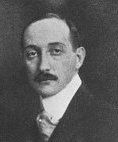| VIAS Encyclopedia provides a collection of tables and definitions commonly needed in science and engineering. |

|

Home  Science History Science History  Biographies Biographies  Robert von Lieben Robert von Lieben |
|||
| See also: Karl Ferdinand Braun | |||






|
|||
Robert von Lieben
Robert von Lieben was born on September 5, 1878 in Vienna as a son of the well-known and rich Jewish banker, Leopold von Lieben. After his schooling, he worked as an unsalaried employee at Siemens-Schuckert in Nürnberg and then visited scientific lectures at the University of Vienna. In 1899, he moved to Göttingen and became a student of Walther Hermann Nernst. He did not complete his studies, and his wealth allowed him to be independent. However, he owned a private laboratory, where he pursued his research, as well as a telephone factory in Olmütz. From 1905, he reduced his work on a camera, a phonograph, an electromagnetic transmission for cars and an airplane in favor of the amplification of telephone currents. The cathode ray and the Wehnelt cathodes were his main concern. In 1906, he registered a patent which described how to control the cathode current using a magnetic field. This patent also included the discussion of the possibility of influencing the electron beam by electrostatic diversion. The implementation of the idea took four years and led to the so-called Lieben tube in 1910, which possessed a control grid. In 1912, the rights to the tube were taken over by a consortium of Siemens & Halske, Telefunken, AEG and Felten & Guilleaume. When the American physicist and chemist, Irving Langmuir, was able to produce a high vacuum for the first time, the tube was then developed in 1914 in large series. From 1910, he suffered ever more severely from a painful, swollen lymph node, which probably came from a fall from the horse during his military service. On February 20, 1913, he died in Vienna at the age of 35.
|
|||
Home  Science History Science History  Biographies Biographies  Robert von Lieben Robert von Lieben |
|||
Last Update: 2010-12-15


